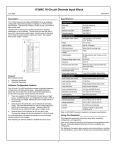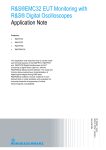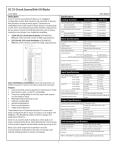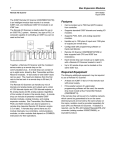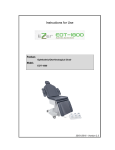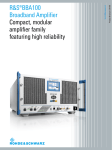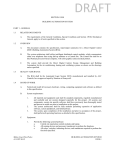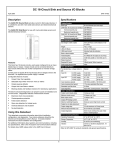Download Genius Voltage/Current Analog I/O Blocks datasheet, GFK
Transcript
This Datasheet for the IC660BBA100 Block 115Vac Analog 4 Inputs / 2 Outputs http://www.cimtecautomation.com/parts/p-14422-ic660bba100.aspx Provides the wiring diagrams and installation guidelines for this GE Series 90-30 module. For further information, please contact Cimtec Technical Support at 1-866-599-6507 [email protected] Voltage/Current 4 Input/2 Output Analog Blocks June 2002 GFK-0048E Description _____________________________________ Specifications __________________________________ Catalog Numbers Voltage/Current 4 Input/2 Output Analog Blocks have four independent input circuits and two independent output circuits. Two block versions are available: 115 VAC Voltage/Current Analog I/O Block (IC66*BBA100) 24/48 VDC Voltage/Current Analog I/O Block (IC66*BBA020) 115 VAC Analog I/O Block Terminal Assembly IC66*TSA100 Electronics Assembly IC66*EBA100 24/48 VDC Analog I/O Block These blocks are identical except for the power supply. IC66*BBA100 IC66*BBA020 Terminal Assembly IC66*TSA020 Electronics Assembly IC66*EBA020 Block Specifications Analog In/Out (115V 50/60Hz) (.1A Max) Size (height x width x depth) 8.83” (22.44cm) x 3.34” (8.48cm) x 3.91” (9.93cm) Weight 4 lbs. (1.8 kg) LEDs (I/O Block) Unit OK, I/O Enabled Block to Block Isolation 1500 V Heat Dissipation 6 Watts Block Power (nominal); 115 VAC 24/48 VDC 98-132 VAC 10VA 47-63Hz 1 cycle 18-56 8W 10% max. ripple 10ms Operating range Maximum power Frequency/ripple Power supply dropout time 50mS Pt/Max Features ______________________________________ Common mode rejection Common mode voltage 60 dB (0-1 KHz) +/-170 volts, maximum Absolute accuracy (at 25°C): Typical: +/-0.2% of full scale; Maximum: +/-0.5% of full scale: Each circuit on an 4 Input/2 Output Analog Block can accept or provide signals in one of five analog ranges: Within: 0-10 volts DC -10 volts DC to +10 volts DC Thermal drift (from 25°C): Typical: 10 PPM per °C; Maximum: 40 PPM per °C Circuit range selections 0-10 VDC, +/-10 VDC, +/-5 VDC, 0-5 VDC, 4-20 mA (or 1-5 VDC) -5 volts DC to +5 volts DC 0-5 volts DC 4-20 mA/1-5 volts DC External scaling resistor: to set full scale to 5 volts for 10mA to 50mA loops This flexibility allows these blocks to be used with a wide variety of analog input and output devices. The block’s internal power supply drives current mode output loads up to 300 Ohms each. For loads up to 2K Ohms, an external 24 or 48 VDC power supply can be used. 1/2 Watts or greater 100W / 1 Watt Input Specifications Input resolution Input update frequency Input filter ranges Input diagnostics Configurable block features include: 50mV on the 10 volt range, 25mV on the 5 volt range, 100mA on the 4 to 20 mA range. Independent scaling for each input and output. Fault reports to the host can be enabled or disabled for each input and output. Selectable Input Filter Time up to 1024ms. Each input can operate in normal analog input mode, or report only its alarm status. Low and high alarm limits for each input, in either normal input mode or alarm input mode. Powerup default values for each output. Each output can be configured to hold last state or default if CPU communications are lost. Input Low Alarm and High Alarm detection. Open Wire detection on current mode inputs. Input Underrange or Overrange. 12 bit + sign Once every 4ms Underrange, Overrange. Voltage mode: 2000 Ohms or greater; Current mode: 0 to 300 Ohms Output Specifications Output resolution Output update frequency Output diagnostics Output load 12 bit + sign Once every 4ms Underrange, Overrange. Voltage mode: 2000 or greater; Current mode: 0 to 300 Ohms Refer to GFK-0867 for product standards and general specifications. * In the presence of severe RF interference (IEC 801-3, 10 V/m), accuracy may be degraded to +/- (0.5% of full scale reading plus 0.5% of reading). Output Underrange or Overrange. 1 Voltage/Current 4 Input/2 Output Analog Blocks June 2002 GFK-0048E Compatibility _________________________________ Grounding These blocks are backward-compatible with earlier versions, and may be used to replace them. The block’s mounting screws must not be used as the only means of grounding the block. Connect the green ground screw on the block to a reliable ground system using a short wire lead, minimum size AWG #12 (avg 3.3mm2 in cross-section). Any Hand-held Monitor (IC66*HHM500 or HHM501) can be used with these blocks. However, Hand-held Monitor model IC66*HHM501 is required to change baud rate configuration, or to configure redundancy features. Note that older HHM model IC66*HHM501 version 3.5 may incorrectly display the message WIRING ERROR during normal operation. Upgrading the HHM to a later version corrects this problem. Warning If mounting screws do not make good ground connection and the ground screw is not connected to a reliable ground, the block is not grounded. Electrical shock hazard exists. Death or personal injury may result. For an IC697 series PLC, the CPU and programming software must be version 2.0 or later. The bus controller must be IC697BEM731C or later. Block Wiring _________________________________ Do not overtorque the terminal screws. Recommended torque for all terminals is 6 in/lb (.678 N/M). For an IC600 series PLC, the CPU must be rev. 105 or later. For an IC600 series “Plus” PLC rev. 110 or later is required. The programming software must be rel. 4.02 or later. Serial Bus Wiring For an IC550 series PLC, the CPU must be rev. 3.0 or later. The programming software must be rel. 2.01 or later. Terminals 1 to 4 are for the serial bus. These terminals accept one AWG #12 wire (avg 3.3mm2 cross-section) or two AWG #14 wires (each avg 2.1mm2 in cross-section). The minimum recommended wire size is AWG #22 (avg .36mm2 in cross-section). Current-source analog blocks are preferred for current-loop applications. Please request information about: 115VAC/125VDC Current-source Analog 4 Input/2 Output Block (IC66*BBA104) 24/48 VDC Current-source Analog 4 Input/2 Output Block (IC66*BBA024) 115VAC/125VDC Current-source Analog Output Block (IC66*BBA105) 115VAC/125VDC Current-source Analog Input Block (IC66*BBA106) 24/48 VDC Current-source Analog Block Input Block (IC66*BBA026) Terminals 1 - 4 can also accommodate spade or ring terminals up to 0.27 inch (6.85mm) wide with a minimum opening for a #6 screw, and up to 0.20 inch (5.1mm) depth from the screw center to the back barrier. Be sure unshielded wire ends are not longer than 2 inches (5 cm). Using one of the cable types recommended in the System and Communications User’s Manual, connect the serial bus to terminals 1- 4. Using this Datasheet ____________________________ This datasheet summarizes information about block installation, configuration, and diagnostics. 1 SERIAL 1 2 SERIAL 2 Your primary reference should be the Discrete and Analog Blocks User’s Manual. It includes detailed instructions for block installation and configuration. 3 SHIELD IN 4 SHIELD OUT For additional information about systems and communications, including bus specifications, refer to the I/O System and Communications Manual. If the block is at either end of the bus, connect a terminating resistor of the appropriate type (see the System and Communications User’s Manual for details) across its Serial 1 and Serial 2 terminals. Installation Instructions _________________________ Start of Bus Carefully inspect all shipping containers for damage. If any equipment is damaged, notify the delivery service immediately. Save the damaged shipping container for inspection by the delivery service. After unpacking the equipment, record all serial numbers. Save the shipping containers and packing material in case it is necessary to transport or ship any part of the system. Terminating Resistor Serial 1 Serial 2 Shield In Shield Out Block Mounting Genius I/O blocks are considered "open equipment" and therefore must be installed within a protective enclosure. They should be located in an area that is clean and free of airborne contaminants. There should be adequate cooling airflow. The block can be mounted right side up, or upside down. Leave at least 2 inches of space between blocks. Mount the block by drilling two screw or bolt holes for 8-32 hardware. Position the block so that the notches in the upper and lower flanges line up with the mounting holes. Mount the block using 8-32 screws. Use star washers to provide ground integrity. 2 End of Bus Terminating Resistor Serial 1 Serial 2 Shield In Shield Out Voltage/Current 4 Input/2 Output Analog Blocks June 2002 GFK-0048E If current mode (4-20mA) is used for an input without an external resistor, connect a jumper from the terminal marked JMP to the terminal marked RTN for that circuit. Field Wiring ___________________________________ Terminals 5 to 32 are for field devices. They take a single wire up to AWG #14 (avg 2.1mm2 in cross-section). Minimum recommended size is AWG #20 (avg .54mm2 in cross-section). If an input current device operates outside the 4-20mA range, connect a resistor across the voltage inputs. For example, to measure 10mA to 50mA current loop signals, install a 100 ohm resistor. Wiring for Block Power If current mode is used for an output circuit, use the terminals marked I+ and I-. For outputs set up in current mode, the block’s internal power supply can be used to drive loads up to 300 Ohms per output. For loads up to 2K Ohms, use an external power supply. Connect the positive lead of the external supply to one side of the load, and the negative lead of the external supply to block common on terminal 29. If the external supply is between 24V and 50V, you can use terminal 25 or 30 as a tie point for the positive connection. This point will be disconnected from the external supply by a reverse biased diode. For block power, connect the power source to terminals 6 and 7. For a 24/48 VDC block, connect the source to the DC+ terminal and the return to the DC- terminal. For a 115 VAC block, connect the source to the H terminal and neutral to the N terminal. For the 115 VAC block version (IC66*BBA100) only, if Class 1 Division 2 conditions must be met for Factory Mutual, install an external 250 volt 1/8 amp slow-blow fuse in series with the Hot AC power connector as shown below. Removing an Electronics Assembly _______________ 250V, 1/8 Amp Slow-Blow Fuse H The block’s Electronics Assembly can be replaced with a compatible model without removing field wiring or reconfiguring the block. 6 ~ N Electronics Assembly 7 Retaining Screws (Qty. 2) Wiring for I/O Devices The ground (GND) terminal (5) is for block safety. It is connected internally to the block chassis, and to terminals 12, 20, and 28, which are marked GND. Each pair of signals has one ground terminal and one common terminal, for shield termination if desired. The three common terminals are connected together internally to the source. BA100 Terminal Assembly Connector Pins BA020 6 6 7 7 ~ NEUT Power for each model 1 Serial 1 2 Serial 2 3 Shield In 4 5 6 Power 7 8 9 10 V 11 12 13 14 i * 15 16 17 18 V 19 20 21 22 i ** 23 24 25 26 Load 2000 Ohms max. 27 28 29 30 Load 0-300 Ohms 31 32 Shield Out GND DC+ DC NC IN JMP RTN GND COM IN JMP RTN IN JMP RTN GND COM IN JMP RTN I+ IVOUT GND COM I+ IVOUT 1. Unscrew the retaining screws at the top and bottom of the block. 2. Using a Block Puller (IC660BLM507), engage the tabs in the first vent slots. Move the tool to the center of the block and squeeze the handle. 3. Pull the Electronics Assembly upward. Warning If power is applied to the field terminals, power is also exposed on the connector pins at the base of the Terminal Assembly, and electrical shock hazard exists. Do not touch the connector pins! Death or injury may result. Input 1 Input 2 Inserting an Electronics Assembly Input 3 1. Align the Electronics Assembly in the guides and push down firmly. Caution Input 4 Do not exert excessive force; it may damage the block. Output 1 2. If unusual resistance is met, remove the Electronics Assembly. If power is applied to the block, DO NOT TOUCH THE CONNECTOR PINS! Inspect the Terminal Assembly, connector receptacle, and connector edge board (on the Electronics Assembly). Be sure the keying matches. Remove any obstacles and reinsert the Electronics Assembly. Pay close attention to the alignment of the guide pins. 3. Secure the Electronics Assembly with the screws on the top and bottom of the Terminal Assembly. Output 2 * External Connection ** External 100 Ohm, 1 W Precision Resistor for 10mA to 50mA range. For a voltage input device, connect the device in series between V+ and the terminal marked IN for that input. Connect V- to the terminal marked RTN. For a voltage output device, connect the load to the terminals marked VOUT and COM for that output. 3 Voltage/Current 4 Input/2 Output Analog Blocks June 2002 GFK-0048E Block Operation ________________________________ Diagnostics _________________________________ The first four circuits on the block are inputs. They convert incoming signal voltage or current to a digital count value in the range +/-4095. If scaling has been configured for an input, the block automatically scales the digital count value to an engineering units value. The block’s advanced diagnostics provide the messages listed below. Fault messages can be cleared from the Hand-held Monitor or the CPU. A/D Low Alarm: Input under its low alarm limit Open Wire: Input configured for 4-20mA is below 2mA Analog to Digital Converter Processor High Alarm: Input over its high alarm limit IN Shield AMP MUX Overrange: Signal exceeds +32767 engineering units or +4095 counts JMP Filter Underrange: Signal exceeds -32767 engineering units or -4095 counts RTN Configuration ___________________________________ COM NOTE: Common ground and case ground are shared between Power Supply Ground two output channels GND Case First, the block must be configured with a Hand-held Monitor to: Ground Circuits 5 and 6 are outputs. The block will automatically scale an engineering units output from the CPU to a digital count value in the range +/-4095. The D/A converter then converts the digital value to an output signal voltage or current. +20V +1 -1 VOUT COM GND Buffer Amplifier V to I Converter Sample Hold Circuitry S/H Enter its Device Number (serial bus address). Enter its Reference Number (required only for IC600 and IC550 series PLCs only). Note: If a block is configured offline, it must be properly grounded and have a 75 Ohm resistor installed across its Serial 1 and Serial 2 terminals. See the Discrete and Analog I/O Blocks User’s Manual for instructions. The rest of the features can be configured either using a Hand-held Monitor, or by sending a Write Configuration datagram to the block from the host. 12 bits plus sign D/A Converter D/A Processor Feature NOTE: Power Supply Ground Common ground and case Circuit or Block Factory Setting Selections Device Number Block null 0 to 31 (a number must be selected) Reference Address Block none Depends on host CPU type Each circuit can be configured for scaling to represent a different type or increment of engineering units. The default for each circuit is to operate in the range of +/-10VDC, and to report engineering units of millivolts. If millivolts are not appropriate or if the circuit will operate in a different voltage/current range, the circuit should be rescaled. Instructions are given in the Discrete and Analog Blocks User’s Manual. The possible range of engineering units values is +/-32767. A circuit can also be configured for no scaling; in that case, it uses unscaled digital count values that correspond directly to the actual analog signal level. The range of digital counts values is +/-4095. Baud Rate Block 153.6 std Report Faults Circuit yes 153.6 std, 153.6 ext, 76.8, 38.4 Kbd yes/no Range Select* Circuit +/-10VDC 0-10VDC, +/-10VDC, 05VDC, 5VDC, 4-20mA (15VDC) Scaling Points Circuit +/-10000, +/-4095 +/-32767, +/-4095 Input Filter Time* Circuit 128ms none, 8-1024ms LEDs _________________________________________ Alarm Input Mode Circuit no yes/no The block's Unit OK and I/O Enabled LEDs show its operating status: Alarm Thresholds Circuit +/-10000 +/-32767 Hold Last State Circuit no yes/no Output Default Circuit 0 +/-32767 eng. units BSM Present Block no yes/no Block 3 bus scans 2.5/10 seconds Case Ground ground terminals are shared between output channels Circuit Scaling Unit OK I/O Enabled Meaning ON ON Block functioning, CPU communicating ON OFF Block functioning No CPU communications for 3 bus scans Outputs Default Time ON Blinking Block functioning, Circuit forced CPU Redundancy Block none none/standby Blinking ON Circuit fault, CPU communicating disabled enabled, disabled Blinking OFF Configuration Protection Circuit fault No CPU communications for 3 bus scans Alternate Blinking Circuit fault, Circuit forced Synchronous Blinking No CPU communications - block number conflict OFF No block power, or block faulty OFF Block * These are setup parameters. They must NOT be changed while the block is operating. If either is changed while the block is operating, the voltage of the circuit also changes. 4





